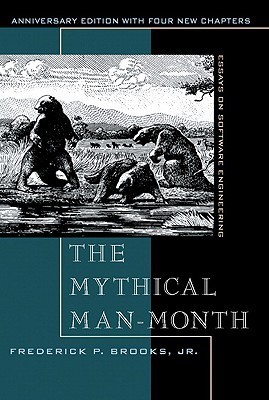As I am nearing the end of my tenure at the company I co-founded a decade ago, I thought it would be useful to share some of the books that were influential to me as I went from engineer to a lead-of-leads.
Code Complete by Steve McConnell

This book probably feels a bit dated as it was published in 2004. However, I found this very useful early in my engineering career as I was learning to build systems that were maintainable and useful. Some of the maxims that McConnell included in this book are true no matter the language. For example, “write programs for people first, computers second.” I often had a tendency to get clever with code rather than trying to be blindingly obvious; being clever tended to produce more pain (both for myself and others) down the road.
The Mythical Man Month: Essays on Software Engineering by Fred Brooks

This book makes “Code Complete” feel quite young as “Mythical” was written in 1975. However, it’s commentary on software development is still timeless (if one can overlook some of the underlying sexism prevalent at the time). Two essays stuck with me more than others.
“There’s No Silver Bullet” highlighted accidental complexity versus essential complexity. Much work has been done to address accidental complexity (especially since 1975!) but essential complexity, the complexity of the underlying problems that we’re trying to solve, will always be with us. This one stuck with me because non-engineering types are constantly enamoured by “silver bullets” - whether it’s data science, machine learning, artificial intelligence, or whatever is coming next. Whenever they come upon a hard problem they ask, “Why don’t we just use [the silver bullet]?” Even engineers like myself can fall prey to this way of thinking. The trouble is that these bullets rarely address the complexity of the underlying problem space.
In “The Mythical Man Month” Brooks asserts that “adding manpower to a late software project makes it later.” He highlights the importance of team communication in complex projects and provides a formula to demonstrate that more people means more and more communication overhead. I’ve heard this described by someone else as “clinks versus drinks.” If you sit at a bar with three people, you clink three times and then you can drink. But as you add more and more people to the party, all of your time is spent clinking with very little time for drinking!
The Nature of Software Development by Ron Jeffries

Ron Jeffries is one of the original signatories of the agile manifesto. The manifesto has been pillaged and plundered by consultants until it has become something completely unrecognizable from the original intent. This book brings it all back home. We’re just here to deliver value to our customers!
The Stratasan and product and engineering teams read this as a group at least twice. I found it to be extremely useful to help everyone get on the same page about how a product-first company delivers value to customers. It helped us use similar vocabulary (“tall and skinnies!” meaning high value, low cost). This book was particularly useful because it explains the process of software development so well that you don’t actually need to be a developer to understand it. That makes it much more useful for development-adjacent roles like product management, QA, etc.
Inspired by Marty Cagan and Chris Jones
Speaking of product management, this book and “Empowered” are aimed more at product managers. The Stratasan team read both of these books as a group and I found them to be extremely helpful to communicate the vision for a true product-first company.
If “The Nature of Software Development” was a good introduction to software development for product managers, “Inspired” was a great introduction to product management for software developers.
Accelerate by Forsgren, Humble, and Kim
One of my biggest gripes with most “business” books is that they rarely have data to back them up. Instead, they tend to rely on overly cute anecdotes to emphasize or validate their assertions. “Accelerate” does not make this mistake. You might be able to point out issues with their data collection (that’s beyond my pay grade) but they certainly have the data.
This book highlights the engineering metrics that correlate best with successful organizations, based on annual surveys performed by the authors. They boil it down to four key metrics. I’m not a fan of metrics for the sake of metrics, but they make a very good case that these four metrics are really the ones you want to watch.
The Manager’s Path by Camille Fournier
This book is broken out in a way that matches the trajectory of most careers in engineering management: from individual contributor, to team lead, to manager of a single team, to multiple teams, and then finally a manager of managers. This was a book I constantly kept on hand as our company grew and I found myself referencing it often.
High Output Management by Andrew Grove
I found the title of this book off-putting at first. Some of the anecdotes and recommendations are a bit heavy on the manufacturing side (not necessarily suitable advice for the creative endeavor of a product company). However, it’s good advice outweighed the anachronisms. It helped me understand a lot of the reasoning behind OKRs. The single thing I took from this book: as a manager, you’re no longer responsible for your work; you’re now responsible for your team’s work. Your job is now to help your team grow. I found this helpful as I was transitioning from an individual contributor, because I still was very tempted to measure my success based on my output, not my teams. Trying to balance individual output and managing a team is a miserable existence: this book got me out of that hole.
Traction by Gino Wickman
This book might feel like the odd-one out in this anthology, but I include it because it had a huge influence on how we ran the day-to-day business at Stratasan. Neither Jason Moore (CEO) nor myself had ever scaled a company to a hundred people. This book and EOS helped us to set up a good cadence of meetings and communication between the various teams. It allowed us to set the strategy, execute on it, and bubble up issues more quickly.
We eventually moved away from stick adherence to EOS, but it served us well as a solid foundation.
What about you?
These are the books that I found to be most helpful during Stratasan’s growth. How about you? What books were instrumental in your professional growth? Leave a comment or shoot me an email (brian at this domain).
Photo by Tom Hermans on Unsplash
